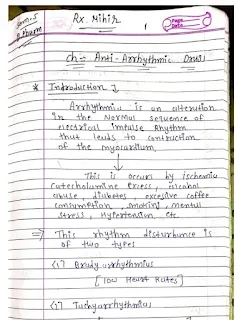Anti-arrhythmic Drugs (Med Chem:- 2) Notes Download
Anti-arrhythmic drugs are medications used to treat abnormal heart rhythms (arrhythmias). These drugs work by altering the electrical conduction in the heart and restoring normal rhythm. Arrhythmias can range from mild to life-threatening, and anti-arrhythmic drugs are classified based on their mechanism of action.
These notes provide a comprehensive overview of anti-arrhythmic drugs, including their classification, mechanism of action, therapeutic uses, and side effects. Download the PDF, notes, or PPT to gain a deeper understanding of this critical topic in medicinal chemistry.
Keywords: Download PDF, Notes, PPT, Anti-arrhythmic Drugs, Medicinal Chemistry, Heart Rhythm, Arrhythmia Treatment, Pharmacology.
Detailed Explanation of Anti-arrhythmic Drugs
Anti-arrhythmic drugs are essential in the management of cardiac arrhythmias, which are irregularities in the heart's rhythm. These drugs are classified into four main classes based on their mechanism of action:
- Class I: Sodium Channel Blockers
- These drugs block sodium channels, slowing the conduction of electrical impulses in the heart.
- Examples: Quinidine, Procainamide, Lidocaine, and Flecainide.
- Class II: Beta-Blockers
- These drugs reduce the heart rate and decrease the force of contraction by blocking beta-adrenergic receptors.
- Examples: Propranolol, Metoprolol, and Atenolol.
- Class III: Potassium Channel Blockers
- These drugs prolong the action potential duration and refractory period by blocking potassium channels.
- Examples: Amiodarone, Sotalol, and Dofetilide.
- Class IV: Calcium Channel Blockers
- These drugs slow the conduction of electrical impulses through the AV node by blocking calcium channels.
- Examples: Verapamil and Diltiazem.
Anti-arrhythmic drugs are used to treat various types of arrhythmias, including atrial fibrillation, ventricular tachycardia, and supraventricular tachycardia. The choice of drug depends on the type of arrhythmia, the patient's overall health, and potential side effects.
While these drugs are effective in managing arrhythmias, they can also have significant side effects, such as pro-arrhythmia (causing new arrhythmias), hypotension, and organ toxicity. Therefore, careful monitoring and individualized treatment plans are essential.
Understanding the pharmacology of anti-arrhythmic drugs is crucial for healthcare professionals, as these medications play a vital role in improving patient outcomes and quality of life.
Info!
If you are the copyright owner of this document and want to report it, please visit the copyright infringement notice page to submit a report.

